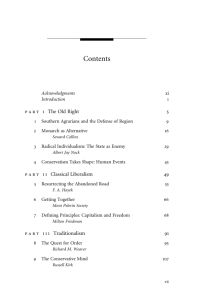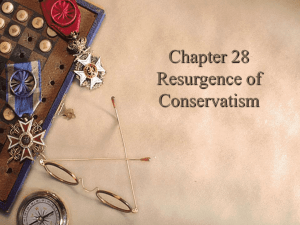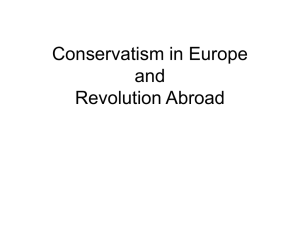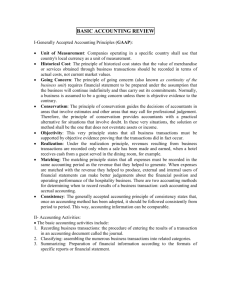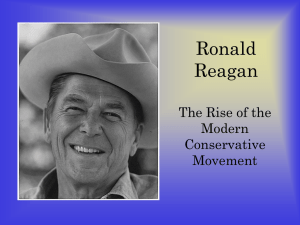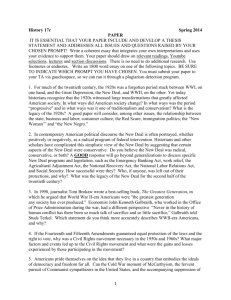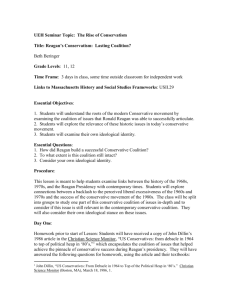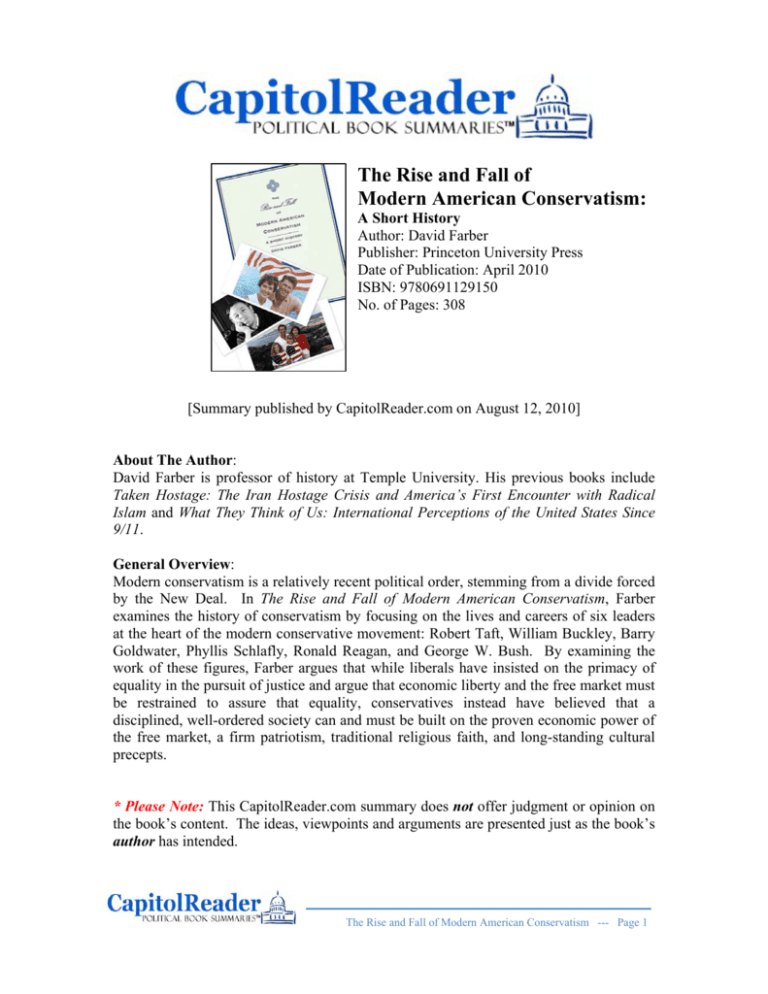
The Rise and Fall of
Modern American Conservatism:
A Short History
Author: David Farber
Publisher: Princeton University Press
Date of Publication: April 2010
ISBN: 9780691129150
No. of Pages: 308
[Summary published by CapitolReader.com on August 12, 2010]
About The Author:
David Farber is professor of history at Temple University. His previous books include
Taken Hostage: The Iran Hostage Crisis and America’s First Encounter with Radical
Islam and What They Think of Us: International Perceptions of the United States Since
9/11.
General Overview:
Modern conservatism is a relatively recent political order, stemming from a divide forced
by the New Deal. In The Rise and Fall of Modern American Conservatism, Farber
examines the history of conservatism by focusing on the lives and careers of six leaders
at the heart of the modern conservative movement: Robert Taft, William Buckley, Barry
Goldwater, Phyllis Schlafly, Ronald Reagan, and George W. Bush. By examining the
work of these figures, Farber argues that while liberals have insisted on the primacy of
equality in the pursuit of justice and argue that economic liberty and the free market must
be restrained to assure that equality, conservatives instead have believed that a
disciplined, well-ordered society can and must be built on the proven economic power of
the free market, a firm patriotism, traditional religious faith, and long-standing cultural
precepts.
* Please Note: This CapitolReader.com summary does not offer judgment or opinion on
the book’s content. The ideas, viewpoints and arguments are presented just as the book’s
author has intended.
The Rise and Fall of Modern American Conservatism --- Page 1
Robert Taft: The Gray Men of Modern Conservatism and the Rights of Property
As the age of Roosevelt ended in the 1930s and 1940s, conservative politics and policies
were championed by politicians who were men of good fortune – rich, privileged,
talented, and accomplished. Senator Robert Taft stood at the forefront of this
conservative corps. The son of President William Howard Taft, he castigated the New
Deal for its big-government, welfare-state, market-regulating ways. He insisted that
economic liberty was Americans’ constitutional birthright.
Taft found his moment in the years after World War II, when he led the effort to stop the
expansion of the New Deal state and forge an outspoken conservative, anti-liberal
Republican Party.
Taft believed that the Constitution aimed, above all, to protect property from the
machinations of economic levelers or financial manipulators. In a speech made while he
was running for Senate in 1938, Taft blasted New Dealers for disregarding the
Constitution in their reckless pursuit of socialistic measures. He intertwined three critical
themes of modern conservatism: fealty to the property-preserving original intent of the
Constitution, contempt for social-experiment-loving intellectual elites who would
disregard tradition, and a reverence for the “Anglo-Saxon race.”
By the early 1940s, the Taftian persuasion was primarily, but not solely, a Republican
one. Both Democrats and Republicans were internally debating the reach of the federal
government in the American economy. However, most Democrats broadly agreed that
Washington should play a major role in safeguarding Americans’ economic security and
prosperity. Taft was disgusted by Roosevelt’s and the Democrats’ presumption. As Taft
understood it, conservatism was a political philosophy that championed individual
liberty. By “liberty,” Taft meant that the government should give broad freedom to
individuals, whether worker or employer, to pursue their economic interests if they were
able enough to take advantage of free market opportunities.
In 1938, Taft ran for the U.S. Senate in Ohio and trounced the pro-New Deal Democratic
incumbent. He was one of eight new Senate Republicans, but conservatives were still a
decided minority at the end of the 1930s. With the outbreak of World War II soon after
taking office, Taft took center stage as an advocate for keeping America out of the
conflagration. An economic unilateralist, he opposed free trade and felt the country
could and should go it alone economically.
When Roosevelt died and the war ended, the nation faced a time of uncertainty as to
whether America would slip back into recession. Taft and his fellow conservatives saw
political opportunity amid this uncertainty and targeted organized labor. As thousands of
strikes broke out, Taft did his best to link President Truman and his fellow liberals to the
labor unrest. The 1946 election saw the return of the Republican Party to congressional
control after fourteen years.
The Rise and Fall of Modern American Conservatism --- Page 2
Taft was a politician, not an ideologue. He did not want to destroy unions, but he did
want to reduce their strength by increasing the power of employers. His legislation, the
Taft-Hartley Act, outlawed organized labor tactics such as the secondary boycott and
unionizing of shop foremen. It also gave employers increased tools to fight unionization
campaigns. The Act served as a symbol of the shifting relationship between the unions,
the state, and the corporations at the dawn of the postwar era.
William Buckley: Building the Conservative Political Culture
After Robert Taft died in 1953, no single figure in the political establishment carried the
political torch. Americans seemed under the sway of moderate, middle-of-the-road
politics. William Buckley was just 28 at the time of Taft’s death, but had already
published a book attacking secular liberalism, God and Man at Yale.
Buckley is vital to the evolution of modern conservatism for four reasons. First, he began
to disengage intellectual conservatism from the realm of elitists and reactionaries and
more into the public. Second, he marketed his charming self in the national media and
gave conservatism a human face. Third, he was an institution-builder who helped to
create a public arena where conservative ideas and policies could be thought about and
where personalities could be presented as models. Fourth, and most important, he found
ways to link devoutly religious, educated Americans to the conservative political cause.
Born in 1925, Buckley was conservative from day one and shocked no one who knew
him by becoming the herald of new American conservatism while still in his twenties.
Buckley’s basic charge in God and Man at Yale was that the principles necessary for
virtuous human conduct and observance of man’s place in God’s universe were being
willfully subverted by arrogant elites such as the academics at Yale. This charge would
remain a consistent theme for conservatism in years to come. Deeply religious
Americans, especially fundamentalist Christians, feared that secular intellectuals were
gaining control of American life.
By the 1950s, most Americans had joined the anticommunist bandwagon. The question
for several decades to come revolved around how to fight the communist enemy.
Conservatives, and Buckley, believed that war at home against the Left was at least as
important as the battle abroad. Buckley was a firm supporter of Senator Joseph
McCarthy’s efforts. In Buckley’s book, McCarthy and His Enemies, he articulated the
position that he would hold over the next several decades: that the war at home was not
so much between communists and anticommunists as it was between weak-willed naïve
liberals and stout, principled conservatives. By the time the book was published,
however, McCarthy had lost his hold on the American public, so Buckley’s book was
perceived as zealous McCarthyism by Republican moderates.
After marrying the heiress Pat Taylor and working brief stints in both the CIA and for the
conservative American Mercury magazine, Buckley launched America’s great magazine
of conservative opinion, the National Review. His goal with the magazine was not to
The Rise and Fall of Modern American Conservatism --- Page 3
grow a grass-roots constituency, but to influence the opinion makers. He crafted an
ironic tone for the magazine that made conservatives appear dashing and clever. But, he
had to protect that brand of intellectually respectable conservatism from a zealotry that
certain elements of the Right-wing anticommunist forces had brought to the fray, such as
Robert Welch and the John Birch Society, who alleged that President Eisenhower himself
was an agent of the Communist conspiracy.
Similarly, although Buckley opposed the Civil Rights Movement and supported
segregationists, he and the National Review team generally dismissed arguments that
used white supremacism to legitimate racial discrimination. Instead, they supported
whites’ right to segregate and discriminate on racial grounds because the federal
government had no right to meddle in the lives of individuals or the states.
All through the 1950s and 1960s, Buckley maintained and deepened conservatives’ longstanding faith in unrestrained free market economics. He took conservatives’ narrow
economic policy and contributed a culture to their cause. He built cultural platforms and
constituencies that gave form and substance to the more forthrightly political movement
that was ready to charge forward in the early 1960s.
Barry Goldwater: Cowboy Conservatism, Race Politics, and the Other Sixties
Barry Goldwater helped invent modern, populist conservatism. For Goldwater,
conservatism wasn’t as much an intellectual political philosophy as it was a matter of
common sense: America faced dangers at home and abroad, so if you loved America,
communism had to be stopped and liberty had to be preserved.
Two issues dominated national politics in the early 1960s: the threat of Soviet
communism and the fight against racial injustice. Before 1960, there was little difference
between conservatives and liberals on these issues.
Goldwater took things back to basics. He warned that the nation must reject big
government and soft-on-communism liberals and “return to the faith in the flag, Bible,
family, and self.” In 1960, Goldwater wrote (with a ghost writer) a book outlining his
conservative political beliefs. His book, The Conscience of a Conservative, surprised
everyone by becoming a massive bestseller and it made Goldwater a major public figure.
The book neatly summed up three conservative virtues of the time:
1) Champion economic liberty by fighting communism, labor unions, and federallymandated business regulation.
2) Respect tradition, even if it meant supporting segregationists.
3) Demand public order, including criticizing the disruptive protests of the Civil
Rights Movement.
Between 1960 and 1964, conservatives organized in an unprecedented way to gain the
presidential nomination for Goldwater. Conservatives had to beat back the efforts of the
party’s Northeastern wing to select a more middle-of-the-road candidate, so Goldwater’s
team had to unify and politicize a grass-roots activist base.
The Rise and Fall of Modern American Conservatism --- Page 4
After President Kennedy’s assassination, President Lyndon Johnson told the American
people that they could best honor Kennedy by passing national civil rights legislation.
Overwhelmingly, Republicans endorsed the measure, reminding civil rights activists that
the GOP was the traditional party of civil rights. Goldwater, however, disagreed, stating
that the Civil Rights Act would make the federal government into a “police state,” and
lead to “the destruction of a free society.” Still, the Civil Rights Act passed
overwhelmingly.
A few weeks later, the 1964 Republican National Convention opened. Goldwater had the
nomination in the bag. Among the groups active in the nomination fight for Goldwater
were the Young Americans for Freedom and the John Birch Society.
Anti-communism, broadly understood, united most of the Goldwater volunteers. As
Goldwater accepted the nomination, he had harsh words for the liberals and moderates
within his own party and welcomed the Right-wing activist John Birch Society members,
saying, “I would remind you that extremism in the defense of liberty is no vice.”
Goldwater lost big in the presidential election against Johnson, winning just six states,
five of which were in the Deep South. But despite the election blowout, a powerful
grassroots conservative movement aimed at national power had taken shape in his name.
More than one million men and women had contributed money to the campaign or been
mobilized to help.
Goldwater reduced the power of the liberal Republicans and essentially ensured that
moderate Republicans would begin to lean toward the conservative movement activists.
Every Republican presidential candidate after Goldwater would reach out and seek to
expand the new, white conservative base in the South that Goldwater had helped to
create. He inspired a generation of conservative activists and showed them the grit and
political power of “old bare-knuckles frontier conservatism.”
Phyllis Schlafly: Domestic Conservatism and Social Order
Born in 1924, Phyllis Schlafly’s parents experienced economic hardship during the
Depression, but scorned New Deal work relief programs. Schlafly earned a M.A. in
political science from Radcliffe before even turning 21, and afterward became a
researcher at the American Enterprise Association, a pro-business conservative think
tank. After a year there, she returned to St. Louis, where she began to work on
Republicans’ campaigns. When she married Fred Schlafly in 1949, she quit work and
began having children, six in all. While a stay-at-home mother, she continued her
political work with her husband’s blessing and in 1952 ran for Congress as a housewife
candidate. She lost that race in the general election, but threw herself into the fight
against communism.
In the anticommunist movement, women filled the grassroots, activist base. These wives
and mothers dedicated themselves to ridding their children’s schools of teachers and
textbooks they perceived to be threats. In 1958, Schlafly, her husband, and her sister-inlaw formed a national Catholic organization, the Mindszenty Foundation, dedicated to
fighting communism. Schlafly oversaw its education programs and warned followers
The Rise and Fall of Modern American Conservatism --- Page 5
through its publications to beware of communist influences in television, movies, and
public institutions.
In the late 1960s, after Goldwater’s failure, feminism trumped anticommunism as the
new cause. While a general notion of gender equality unified most feminists, by the early
1970s there was much that divided and factionalized the women’s liberation movement,
including the roles of capitalism, religion, sexuality, and family life. Nearly all feminists,
however, supported the Equal Rights Amendment (ERA) for women.
Between the House and Senate’s vote on the ERA, Schlafly denounced the proposed
Constitutional amendment. She argued that since women have babies and men don’t,
society is thus organized to protect women so that they may properly raise their children.
She argued that the ERA would destroy America by (1) making women subject to be
drafted into the military; (2) end women’s rights to financial support from their husbands,
making it possible for a husband to demand his wife go to work; and (3) end a woman’s
near-automatic right to custody of her children in the event of a divorce.
Schlafly worked with members of Congress, but knew that the real battle was at the state
level, where the ratification fight would be waged one state at a time. She held
workshops, set up chapters of her STOP ERA organization, and traveled from state to
state. She taught these new conservative activists how to raise money, get publicity,
make politicians pay attention, and connect with other women who had never done
anything political before.
While fighting the ERA, Schlafly was creating a powerful activist base for the larger
conservative movement. By the late 1970s, Schlafly and her supporters had stopped the
forward progress of the ERA and successfully lobbied several state legislatures to rescind
previous passage of the amendment. She also worked to join her legions’ battle against
the ERA to other cultural battles, including the legalization of lesbian and gay marriage.
Ronald Reagan: The Conservative Hero
Before Ronald Reagan, the biggest champions of modern conservatism were naysayers
who talked of fear and even doom. Reagan, however, pictured conservatism as a
forward-looking and optimistic crusade, which made him the most successful
conservative of them all.
Reagan was born of poor beginnings, but made his own luck and embraced the world as
he found it. From the late 1930s to the early 1950s, Reagan was a liberal Democrat, a
“New Dealer to the core.” How, then, did he turn to conservatism?
In the beginning, there was the anticommunist cause. Most liberals in the late 1940s
were just as anticommunist as most conservatives. But even early on, Reagan was
disappointed by the reticence of his liberal allies in taking on the communists more
aggressively.
The Rise and Fall of Modern American Conservatism --- Page 6
Reagan’s walk away from liberalism gained momentum in the 1950s as his career
accelerated. He began to make big money in the movies and he felt too much was being
siphoned off for taxes. He began to look at the economy from the perspective of a selfmade millionaire, and for the first time ever, in 1952, he voted Republican for
Eisenhower.
In the mid-1950s, Reagan signed on with General Electric to host General Electric
Theater. This job made him a welcome, authoritative TV figure, and directly contributed
to his growth as a conservative political figure. As part of his job, he toured GE’s many
plants and began to mix more and more commentary about national politics into his
speeches, trying to make the anti-tax message a populist one.
In the 1960s, Reagan was the co-chair of Barry Goldwater’s campaign in California.
When Goldwater had to cancel a fund-raising speech at the last minute, Reagan filled in,
giving a variation of his GE speech. Republicans asked him to repeat the speech on
national television. The speech laid out his new core principles: anti-tax and anti-big
government.
As a result of this speech, powerful conservative businessmen in California approached
Reagan about running for governor. He expected to run on the same issues as he’d made
in his speech, but also campaigned on the challenge student protestors were making
against the social order. He, as much as anyone, made the crackdown against leftist
social change movements of the sixties a core aspect of conservative politics. He also
took on racial justice, condemning the Fair Housing Act as it restricted people’s rights to
sell their homes to whomever they wanted.
Reagan was governor of California from 1966 through 1974, becoming one of the
nation’s best known opponents of social change movements. His rhetoric, however,
remained light, making him a populist hero for the way he made a mockery of what
people feared.
During Reagan’s governorship, three issues stood out: taxes, welfare reform, and the
politics of abortion. While Reagan’s number one priority was to cut taxes, his first major
act in office was to call for the largest tax increase in California history, in order to move
the state budget back into the black. He worked with Democrats to reduce welfare rolls
(his goal) while increasing payments for most of those who remained (the liberals’ goal).
As far as abortion politics went, in 1967, the California legislature passed a bipartisan
measure allowing therapeutic abortions in the case of incest, rape, risk to the mother’s
health, or if the fetus showed signs of serious abnormalities. Reagan instinctively
opposed the bill, but allowed it to pass with the stipulation that the “serious abnormality”
clause be deleted. Thanks to Reagan, Californian women had more access to legal
abortions than almost any state in the country.
Between 1976 and 1980, Reagan organized for the 1980 presidential election. He easily
won the Republican nomination, and then the general election.
The Rise and Fall of Modern American Conservatism --- Page 7
During his presidency, Reagan’s major domestic policy successes came in the area of
economics. He advocated tax cuts for all Americans, optimistic that supply-side
principles would result in so much economic growth that budget deficits would take care
of themselves. He experienced more difficulty trying to cut big government, since
Americans did not, in reality, want to see programs they favored get the axe.
In terms of foreign policy, Reagan initially rejected détente with the Soviet Union and
launched a war of words against the Soviets. He began to rethink this position after
learning that some people in the Soviet Union believed this fierce anticommunism and
strident rhetorical attacks were leading to an actual military confrontation. When Mikhail
Gorbachev rose to power, he and Gorbachev began working together, eventually signing
a treaty to reduce the number of nuclear weapons.
Throughout his presidency, Reagan took the dreams and ideas of the conservative
movement that had been in the works for decades and made them conventional wisdom
and the law of the land. He transformed American politics, but also contributed to the
growing polarization of the American people. His social policies remained enormously
divisive as liberals believed his indifference to the plight of the poor and the growing
economic inequality in the United States were terrible wounds to the body politic. Even
with this, however, Reagan left the conservative movement far stronger than he had
found it.
George W. Bush: The Conservative Calling and the Great Crack-Up
When George W. Bush assumed the presidency, he inherited a massive, confident, and
powerful conservative movement. Conservatives owned the Republican Party and
dominated Congress and the policymaking landscape. Bush, however, was an unusual
conservative leader. He found the core of his conservative values not in free-market
economics but in the word of God as revealed in the Bible. During his presidency, he
pursued the conservative agenda and cast aside those cultural and legal norms that he
believed handcuffed America in its battle against evildoers.
While Bush’s beginnings were far from humble, he affected no sense of snobbery or
exclusivity. He also turned the troubled years of his early adulthood, marked by heavy
alcohol use, into a politically compelling narrative of spiritual uplift. In 1985, at 39 years
of age, Bush joined the Community Bible Study group in Midland, Texas. This new faith
became his bedrock. His discovery of that faith also gave Bush and his political allies a
way to narrate his life, putting a positive spin on an otherwise undistinguished record.
This new image helped Bush win the governorship in Texas in 1994 over Ann Richards.
He focused on tort reform in his campaign, which would become a staple conservative
cause. He also focused on education reform and vowed to harden the state’s juvenile
justice system. He won the election handily and a majority of Texas voters, including
Hispanics, liked what he did as governor enough to reelect him in 1998.
As Bush geared up for a presidential run in 2000, he sought to soften the sometimes
exclusionary language of the conservative movement to reach uncertain voters. He made
The Rise and Fall of Modern American Conservatism --- Page 8
Clinton’s character a major theme of his campaign, even though he was running against
Al Gore.
Despite the closeness of the Gore-Bush election results, the conservative coalition formed
in the Reagan years mainly held.
In his first term, Bush kept his promise on taxes, signing the Economic Growth and Tax
Relief Reconciliation Act of 2001. Big oil and other traditional energy businesses
achieved major victories as well.
Bush’s first term was running along predictable conservative lines until 9/11/2001. After
9/11, however, the Bush presidency became almost singularly focused on fighting what
Bush called the Global War on Terror. He believed that the American war against “evildoers” served a purpose far greater than basic security and that it would essentially bring
the nation back to a new culture of responsibility.
Bush allied himself with an influential group of neoconservatives (“neo-cons”) who
insisted that the United States had the right to act unilaterally against any and all
international threats, and that the United States had a mission to spread the virtues of
liberty. Bush was entranced by this vision – an opportunity to remake the Middle East –
and in March 2003, went to war against Saddam Hussein. He ran for reelection focusing
on the war in Iraq and narrowly won against John Kerry.
After his reelection, however, one debacle followed another.
His first failure came when he tried to privatize the Social Security system. A few
months later, Hurricane Katrina hit, and the Bush administration’s inadequate response
caused some Americans to wonder if conservatives’ anti-government rhetoric had gone
too far.
By 2008, a majority of Americans had lost faith in the president’s decision to wage war
and were disgusted by the harsh measures the Bush administration had taken against
“enemy combatants.”
The last straw was the crash of the financial market, caused by a relatively unrestrained
and unregulated free market.
Bush had given modern conservatism a two-term presidency, but his military,
international, domestic, and economic failures dealt the modern conservative movement a
mighty blow. His policy failures were conservative failures and in the eyes of many, the
modern conservative movement had fallen.
ISBN 978-1-77544-904-1 CAPITOLREADER.COM
© COPYRIGHT 2010
ALL RIGHTS RESERVED
The Rise and Fall of Modern American Conservatism --- Page 9

